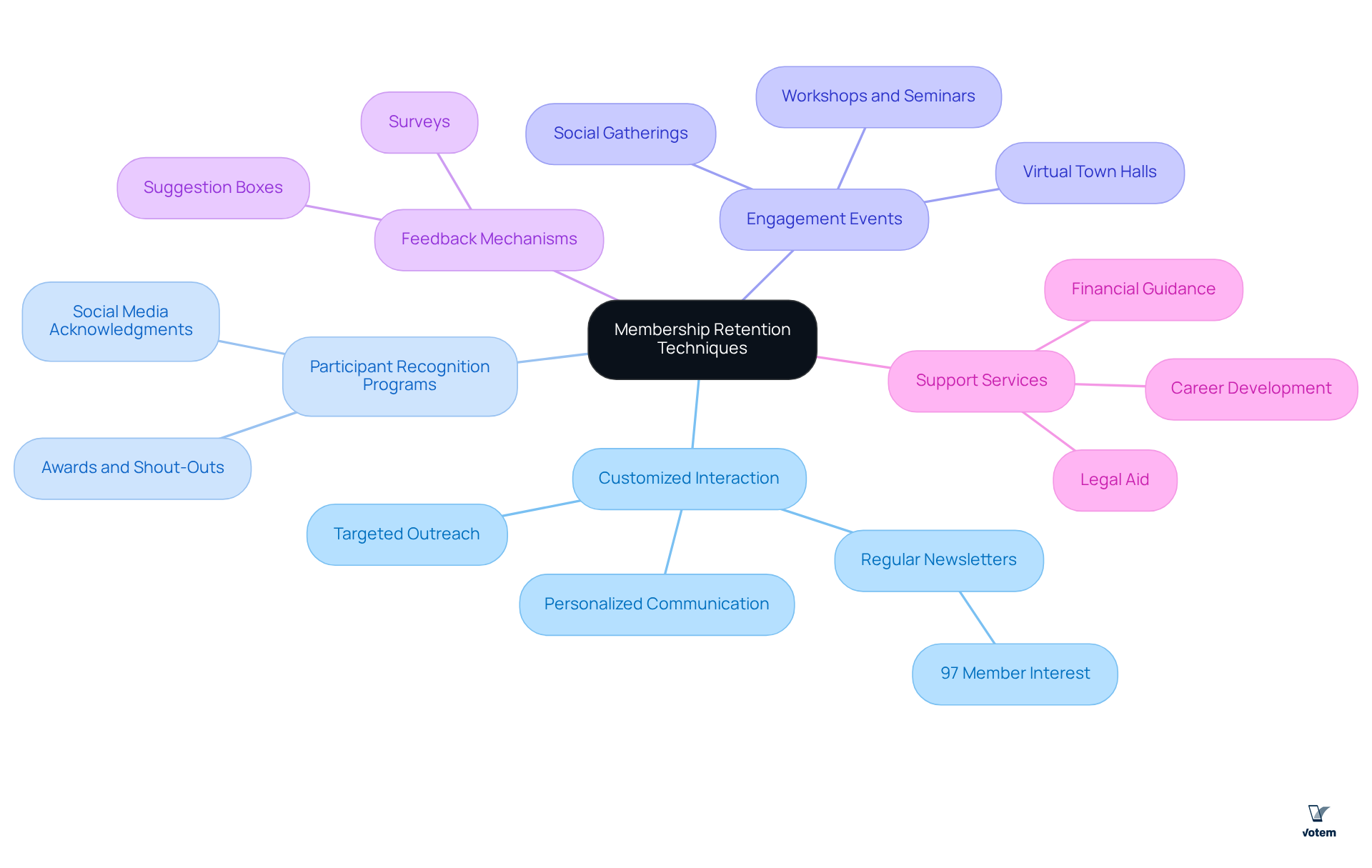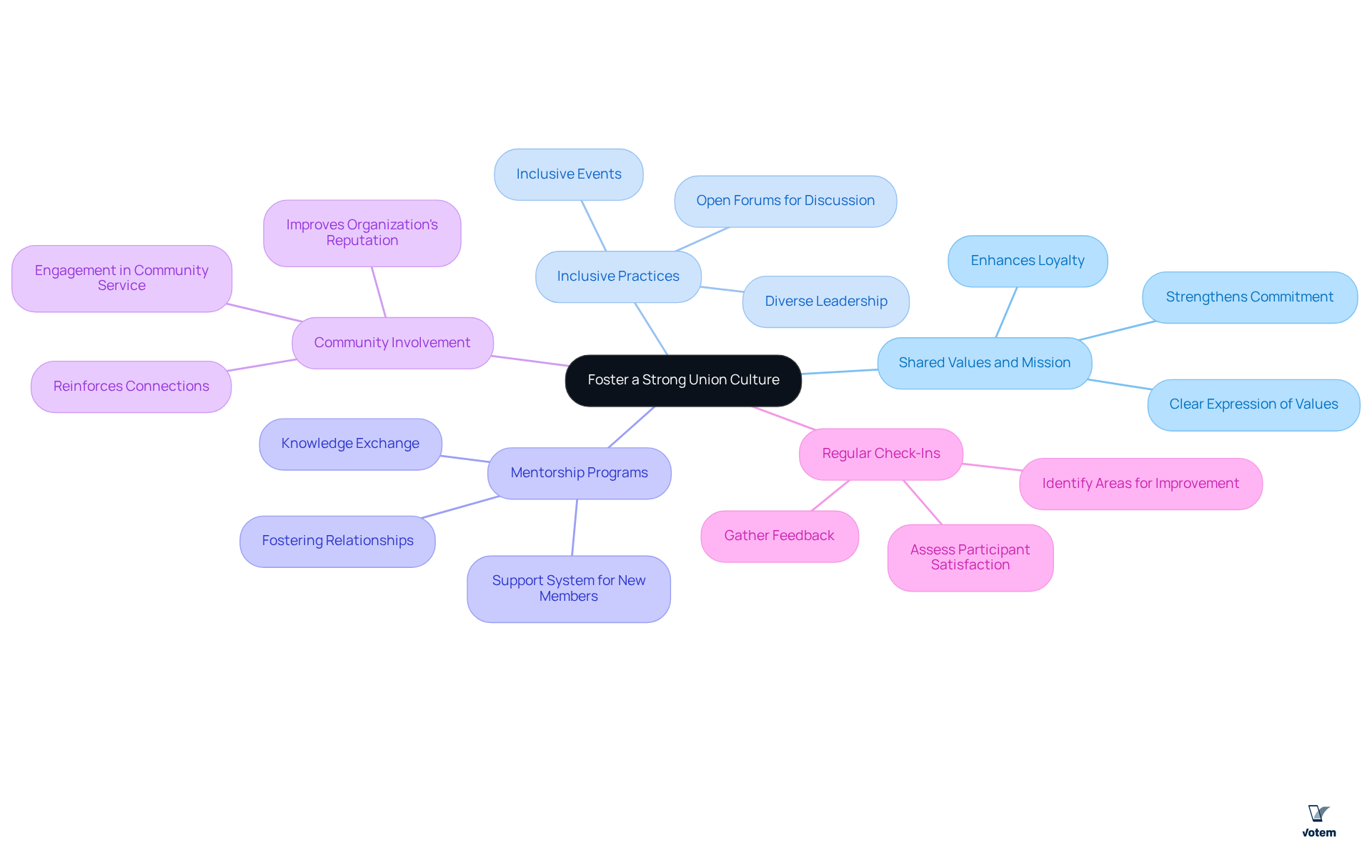Overview
Membership retention in unions can be effectively enhanced through strategies such as:
- Customized communication
- Participant recognition programs
- Engagement events
These approaches foster a sense of belonging and involvement among members, which is crucial for maintaining loyalty. Furthermore, addressing the recent decline in union membership requires a proactive stance from union leadership. By implementing these strategies, unions can create a more engaged membership base, ultimately leading to improved retention rates. It is essential for union leaders to recognize the importance of these initiatives and take action to strengthen their organizations.
Introduction
The challenge of retaining union members is increasingly critical as participation rates wane. Recent statistics reveal a decline from 10% in 2023 to 9.9% in 2024. Unions face the pressing need to attract new members while cultivating a strong sense of belonging among existing ones. This article delves into three essential strategies for enhancing membership retention:
- Tailored communication
- Recognition programs
- Community-building events
By exploring these approaches, we will uncover how they can significantly bolster member engagement. What innovative strategies can unions adopt to reverse the trend of declining membership and foster a thriving, committed community?
Understand Membership Retention in Unions
Maintaining membership in associations presents a complex challenge that hinges on several crucial factors, including participant involvement, perceived value, and the effectiveness of association leadership. It is essential to recognize that retaining participants transcends mere numbers; it involves cultivating a profound sense of belonging and commitment. Research demonstrates that organizations implementing robust participant involvement strategies experience significantly higher retention rates. For instance, unions that actively engage members in decision-making processes and maintain regular communication about activities tend to foster loyalty and satisfaction. Furthermore, recognizing contributions through appreciation notes and reward systems can substantially enhance participant involvement. Gathering input through brainstorming sessions and feedback is also vital for aligning strategies with members’ needs.
In addition, offering professional development opportunities, such as accreditation courses and access to industry conferences, can further boost engagement. Understanding these dynamics is particularly crucial in light of the recent decline in collective membership, which fell from 10% in 2023 to 9.9% in 2024. This trend underscores the importance of developing targeted retention strategies that resonate with participants’ expectations, ultimately enhancing their commitment to the organization. Union leadership must take decisive action to address these challenges and implement solutions that .

Implement Proven Membership Retention Techniques
To effectively retain members, unions must implement several proven techniques that command attention and foster engagement:
- Customized Interaction: Adapting communication to address the specific needs and interests of individuals significantly enhances engagement. Regular newsletters, personalized emails, and targeted outreach can make individuals feel valued and informed. Notably, 97% of union participants express a desire to receive newsletters, underscoring the necessity of consistent communication. As Ken Green aptly states, “So, the takeaway here is simple, keep the information flowing to your participants.”
- Participant Recognition Programs: Recognizing the contributions of participants through awards, shout-outs in meetings, or social media acknowledgments cultivates a sense of belonging and appreciation. Such recognition not only boosts morale but also strengthens the bond between individuals and the organization, which is essential for effective membership retention strategies and improved satisfaction rates.
- Engagement Events: Organizing regular events—such as workshops, social gatherings, and educational seminars—can fortify community ties among members. These occasions provide invaluable opportunities for networking and collaboration, highlighting the importance of membership retention strategies. Moreover, leveraging technology for virtual town halls and community engagement can further enhance participation and awareness.
- Feedback Mechanisms: Establishing channels for individuals to share feedback on collective activities and initiatives allows for continuous improvement and demonstrates that leadership values participant input. Tools like surveys and suggestion boxes can effectively gather insights, ensuring that members feel heard and involved in decision-making processes.
- Support Services: Offering resources such as legal aid, financial guidance, and increases the perceived value of membership. By providing these essential services, unions can enhance their appeal and promote sustained involvement, ultimately fostering improved member loyalty through effective membership retention strategies. Furthermore, utilizing technology for grievance registration and tracking can significantly enhance the assistance available to individuals.

Leverage Technology and Data for Enhanced Retention
Unions can significantly enhance their by leveraging technology and data analytics. Here are some compelling strategies:
- Data Analytics: Employing data analytics tools allows organizations to monitor participant engagement levels, identify trends, and foresee potential dropouts. By examining involvement in events and communication feedback, organizations can customize their strategies to meet the particular needs of individuals. For instance, predictive analytics can pinpoint individuals demonstrating decreased participation, enabling prompt interventions. In 2022, most associations reported retention rates between 75% and 90%, highlighting the importance of membership retention strategies in sustaining membership.
- Mobile Applications: Creating mobile applications for union participants facilitates convenient access to information, event registrations, and communication channels. This convenience can enhance participation and satisfaction, with studies indicating that a mobile-first user experience can elevate turnout by as much as threefold on launch day. Such applications can also support features like real-time updates and group chats, fostering connectivity among participants.
- Social Media Interaction: Actively engaging with individuals on social media platforms cultivates a sense of community and keeps participants informed about organizational activities. Frequent updates, polls, and interactive content can improve participant involvement, making them feel more connected to the union’s mission and initiatives.
- Virtual Meetings and Webinars: Providing virtual meetings and educational webinars aligns with individuals’ schedules and enhances participation. This adaptability is especially significant for younger participants who may favor digital interaction. By offering accessible educational opportunities, organizations can improve the skills and knowledge of individuals, further strengthening their commitment.
- Automated Communication: Implementing automated communication systems ensures timely reminders for events, renewals, and important updates. This proactive strategy aids in avoiding lapses in involvement and participation, enabling organizations to maintain a steady link with their constituents. By utilizing data-driven insights, organizations can tailor communications, making them more pertinent and effective in their membership retention strategies.

Foster a Strong Union Culture
Cultivating a robust organizational culture is essential for enhancing membership retention strategies. To build a cohesive community, consider the following strategies:
- Shared Values and Mission: Clearly expressing the organization’s values and mission aids participants in grasping the purpose of their engagement. This shared understanding can significantly strengthen commitment and loyalty. As Lee Saunders, President of AFSCME, states, “Strong labor organizations mean more vibrant communities and a healthier democracy.”
- Inclusive Practices: Ensuring that all participants feel included and represented within the organization fosters a sense of belonging. Achieving this can involve diverse leadership, inclusive events, and open forums for discussion. Recent statistics reveal that the approval rate for labor unions rose from 67% last year, suggesting that inclusive practices can lead to greater satisfaction and loyalty.
- Mentorship Programs: Creating mentorship initiatives connects experienced individuals with those who are newer, promoting knowledge exchange and fostering relationships. This support system enhances participant satisfaction and implements effective membership retention strategies, as demonstrated by the United Brotherhood of Carpenters and Joiners’ training initiative, which emphasizes soft skills and mentorship to improve workplace culture.
- Community Involvement: Motivating individuals to engage in community service and outreach efforts reinforces connections among participants and improves the organization’s reputation. This involvement fosters a sense of pride and ownership in the organization’s activities, further reinforcing the shared mission.
- Regular Check-Ins: Conducting regular check-ins with participants to assess their satisfaction and gather feedback helps identify areas for improvement. This proactive approach demonstrates that the union values its members and is committed to meeting their needs, which are essential components of effective membership retention strategies, ultimately leading to increased loyalty and reduced attrition.

Conclusion
Membership retention is not merely about maintaining numbers; it is a crucial element for unions that involves nurturing a vibrant community where members feel valued and engaged. The outlined strategies emphasize fostering a sense of belonging through tailored communication, recognition programs, and community-building events. By creating an inclusive culture and leveraging technology, unions can significantly enhance the member experience and commitment.
Furthermore, key insights from the article highlight the necessity of understanding member needs through feedback mechanisms and implementing professional development opportunities. Utilizing data analytics and technology not only streamlines communication but also enables proactive engagement, ensuring that unions remain relevant and responsive to their members’ expectations. The integration of these techniques can lead to higher retention rates and a more engaged membership base.
In conclusion, unions must prioritize membership retention as a vital component of their growth strategy. By embracing innovative practices and fostering a strong organizational culture, unions can cultivate loyalty and satisfaction among their members. Taking these steps will not only enhance individual experiences but also strengthen the union’s overall mission, ultimately contributing to a more robust and unified labor movement.
Frequently Asked Questions
What are the key factors influencing membership retention in unions?
The key factors influencing membership retention in unions include participant involvement, perceived value, and the effectiveness of association leadership.
Why is participant involvement important for membership retention?
Participant involvement is important because organizations that implement strong involvement strategies experience significantly higher retention rates. Engaging members in decision-making and maintaining regular communication fosters loyalty and satisfaction.
How can unions enhance participant involvement?
Unions can enhance participant involvement by recognizing contributions through appreciation notes and reward systems, gathering input through brainstorming sessions and feedback, and actively engaging members in decision-making processes.
What professional development opportunities can unions offer to boost engagement?
Unions can offer professional development opportunities such as accreditation courses and access to industry conferences to boost member engagement.
What recent trend has been observed in collective membership, and why is it significant?
A recent trend observed is a decline in collective membership, which fell from 10% in 2023 to 9.9% in 2024. This decline underscores the importance of developing targeted retention strategies that align with participants’ expectations.
What actions should union leadership take to address membership retention challenges?
Union leadership should take decisive action to develop and implement solutions that foster a dedicated and engaged membership, addressing the challenges of retention effectively.
List of Sources
- Understand Membership Retention in Unions
- AFGE sees surge in new members as its lawsuits stall Trump’s federal workforce policies (https://federalnewsnetwork.com/unions/2025/02/afge-sees-surge-in-new-members-as-its-lawsuits-stall-trumps-federal-workforce-policies)
- unionware.com (https://unionware.com/news-stories/union-member-engagement)
- ironmountaindailynews.com (https://ironmountaindailynews.com/opinion/2025/04/why-does-union-membership-keep-declining-in-the-country)
- (https://nationaldefensemagazine.org/articles/2025/4/1/unions-say-retention-not-hiring-is-shipbuilders-biggest-problem)
- State of the U.S. Unions 2025 (https://ericdirnbach.medium.com/state-of-the-u-s-unions-2025-34ad1e2974da)
- Implement Proven Membership Retention Techniques
- Keeping a Union Strong and Cohesive | Unions United (https://jamspathways.com/news-insights/unions-united-how-to-keep-your-union-strong-and-cohesive)
- Rethinking Union Member Communication and Engagement – UnionTrack® (https://uniontrack.com/blog/rethinking-union-member-communication-and-engagement)
- Keeping the Members Informed (https://ueunion.org/stwd_keeping_members_informed.html)
- cnwr.com (https://cnwr.com/blog/empowering-labor-unions-with-it-enhancing-member-engagement-and-communication)
- UAW and AFA labor union wins tied to strong communication strategies (https://axios.com/2024/05/16/labor-union-wins-communication-strategy)
- Leverage Technology and Data for Enhanced Retention
- How do we retain more members in our unions? – TUC Digital Lab (https://digital.tuc.org.uk/how-do-we-retain-more-members-in-our-unions)
- Data-Driven Union Organizing (https://numberanalytics.com/blog/data-driven-union-organizing)
- How to Use Data Analytics to Improve Member Retention in Unions | SwiftFox | Everything you need to compete. Whatever your goal. (https://swiftfoxcrm.com/blog-posts/how-to-use-data-analytics-to-improve-member-retention-in-unions)
- Three key ways to use innovation and technology for union growth | Alex White (https://alexwhite.org/2023/09/three-key-ways-to-use-innovation-and-technology-for-union-growth)
- Engaging Younger Union Members with Technology (https://nepmedia.net/post/engaging-younger-union-members-with-technology)
- Foster a Strong Union Culture
- shrm.org (https://shrm.org/executive-network/insights/people-strategy/resurgence-unions-how-strong-lasting-greehouse-summer-2024)
- Gen Z’s new pro-union push (https://bbc.com/worklife/article/20230831-the-gen-zers-leading-a-new-pro-union-push)
- A Building Trades Union ‘Sets An Ambitious Goal – Transforming Job Site Culture’ – WNY Labor Today: Your On-Line Labor Newspaper, Bringing You Labor News From Across The Nation, New York State & Western New York (https://wnylabortoday.com/news/2025/06/18/labor-news-from-washington-d.c./a-building-trades-union-sets-an-ambitious-goal-transforming-job-site-culture)
- Support for Unions Hits 70-Year High as US Workers See Power of Organized Labor | Common Dreams (https://commondreams.org/news/support-for-unions)
- Want a Healthier Workplace Culture? Unionize. (https://inthesetimes.com/article/labor-union-washingtonian-merrill-covid-reopening)

